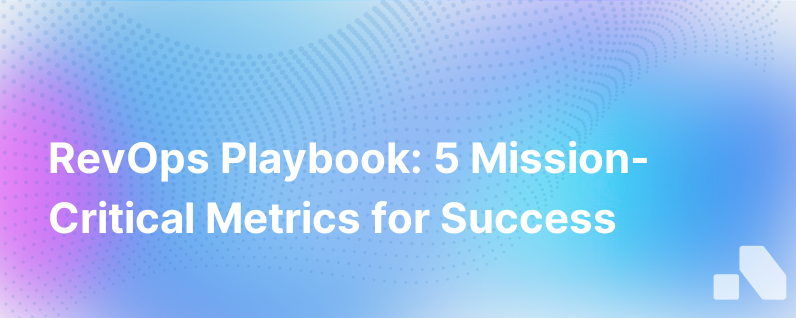The Revops Playbook 5 Mission Critical Metrics
Published on October 29, 2023 by David Zhang
Revolutionizing sales, marketing, and customer service with a collaborative, data-driven approach, the term 'Revenue Operations' or 'RevOps', for short, has quickly become a mainstay in the modern business lexicon. At its core, RevOps is about fostering unity across revenue-generating departments to improve operational efficiency, drive growth, and streamline the customer journey from the first touchpoint to the closed deal and beyond.
Central to this unified approach is a reliance on key metrics that guide decision-making, forecast outcomes, and track performance. Here’s an in-depth look at five mission-critical metrics that should be at the heart of any RevOps playbook.
1. Customer Acquisition Cost (CAC)
Understanding the total cost of acquiring a new customer is crucial. Divide the sum of your sales and marketing expenses by the number of new customers acquired in a given period, and you'll have your CAC. It encompasses advertising costs, salaries for sales and marketing teams, technology and tools, and any external agency fees.
A close eye on CAC helps to adjust strategies, streamline operations, and ensure that departments aren't over-spending to acquire new customers. However, measuring CAC isn't enough on its own; it must be contextualized alongside customer lifetime value (CLV) to paint a complete picture of customer profitability.
2. Customer Lifetime Value (CLV)
Opposite to the CAC is the CLV, which statistically measures the total revenue you can expect from a single customer account throughout their business relationship with you. This metric helps RevOps teams tune their focus not just on winning customers, but nurturing them for long-term profitability.
Calculating CLV involves estimating the average purchase value, multiplying it by the average purchase frequency rate, and multiplying that total by the average customer lifespan. It underscores the critical importance of customer retention and the value of maximizing the revenue potential of each customer.
Placing CAC in relation to CLV offers a telling ratio. A CLV/CAC ratio of 1:1 means you're spending as much to acquire a customer as they’re worth, which spells trouble for your profitability. As a point of reference, a healthy CLV/CAC ratio is typically considered to be around 3:1, but this can vary by industry.
3. Sales Pipeline Velocity
Sales pipeline velocity measures the speed at which leads move through your sales pipeline and become paying customers. It's calculated by multiplying the number of deals in your pipeline by the average deal value and win rate, then dividing by the length of your sales cycle.
Improving pipeline velocity is often a complex endeavor that requires aligning marketing and sales to ensure a seamless transition of leads and opportunities. It also frequently necessitates optimizing sales processes to reduce any unnecessary friction that could slow a deal’s progress.
High pipeline velocity indicates a healthy, efficient sales process, while a low velocity can signal bottlenecks that need addressing. This is a critical metric for RevOps as it’s a direct measure of operational effectiveness across teams.
4. Net Promoter Score (NPS)
NPS measures customer satisfaction and loyalty by asking one simple question: "On a scale from 0 to 10, how likely are you to recommend our company/product/service to a friend or colleague?" Depending on their response, customers are categorized as Promoters, Passives, or Detractors.
NPS is a leading indicator of future company growth. Positive word-of-mouth from Promoters can fuel organic growth without proportional increases in sales and marketing expenditure. Conversely, a high number of Detractors may predict churn and serve as a wake-up call to review the quality of the product or service.
While not a traditional sales metric, NPS is vital for RevOps because it cuts across all departments and spotlights the need for a holistic approach to driving revenue growth, which includes customer experience management.
5. Churn Rate
The churn rate measures the percentage of your customers who terminate their relationship with your business over a certain period. It reflects both product satisfaction and the effectiveness of customer service.
To calculate the churn rate, divide the number of customers lost during a period by the number of customers at the start of that period. It gives you a direct view of how well you’re retaining customers – a low churn rate indicates high customer satisfaction and vice versa.
A low churn is critical for sustaining revenue growth. Losing existing customers can have a more significant negative impact on revenue than less aggressively acquiring new ones since the cost to retain customers is typically lower than the cost to acquire new ones.
RevOps Playbook in Practice
Implementing a RevOps model focuses on metric-driven performance and, when done correctly, can be transformational. The RevOps playbook ensures that every member of the team, whether in sales, marketing, or customer success, pulls in the same direction, guided by these mission-critical metrics.
Take each metric as a chapter in your RevOps playbook. By utilizing platforms like Aomni, you can effectively monitor, assess, and act on these metrics. Aomni offers real-time data and analytics, enabling RevOps teams to stay agile, pivot when necessary, and maximize revenue potential.
By embracing these five metrics within your RevOps framework, you optimize resources, enhance the customer experience, streamline processes, and set up your B2B startup for sustainable growth. As data continues to be the compass for business strategies, a well-designed RevOps playbook powered by accurate, up-to-date metrics is indispensable for any forward-thinking business aiming to expand its revenue stream intelligently and efficiently.